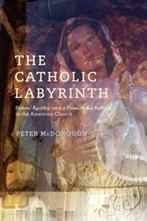Peter McDonough. The Catholic Labyrinth: Power, Apathy, and a Passion for Reform in the American Church. Oxford, UK: Oxford University Press, 2013. 408 pp. $29.95. 
A maze is a complex route offering a choice of directions. A labyrinth, by contrast, typically has a single route that leads you from an exterior entrance point to the center. In other words, unlike mazes, labyrinths offer an unambiguous and simple path. Whether Peter McDonough intended to describe The Catholic Labyrinth as a “simple” path is rather doubtful. But ironically, it may actually be an appropriate description.
McDonough, professor emeritus of political science at Arizona State University, is a two-time Fulbright fellow who has spent more than a little time analyzing the history of Catholicism. He’s perhaps best known for his volume on the Society of Jesus, Passionate Uncertainty: Inside the American Jesuits. Writing from a left-of-center perspective, McDonough is a cultural exegete unafraid to critique the unpleasant dimensions of religious life. This book is no exception. However, it is not a screed, as McDonough explains:
The purpose [of this book] is neither to defend nor to indict the church. “Power” and “apathy” take up two-thirds of the subtitle to signal that “a passion for reform” constitutes just one among several positions in American Catholicism—and not an especially homogeneous one at that. My question is why the different strategies emerged in the first place and, second, how they condition the future of the church. (9)
The Catholic Labyrinth presents itself as a behind-the-scenes look at the battle to achieve reform within the Catholic Church. The investigation focuses on numerous challenges facing contemporary Catholicism in America: for example, the sexual abuse scandals, a marked decline in attendance and vocations to the priesthood, and the closing of parishes and parochial schools. Each of these phenomena is influenced by the “Matrix of American Catholicism”—that is, the network of religious traditions, institutions, cultural trends, organizational hierarchy, and power brokers responsible for leading the American church. On this theme, the opening chapters lay valuable groundwork for understanding how recent attempts at aggiornamento (updating or reform of the church) have progressed.
The results of church reform are mixed. In his assessment, McDonough highlights factors that have contributed to the growth and decline of the church. Such analysis consists of interviews with Catholic leaders, “reformers” who come from both sides of the aisle—conservative and progressive. He also conducts in-depth analysis of their Catholic organizations, particularly Survivors Network of Those Abused by Priests (SNAP), Voice of the Faithful, Leadership Roundtable, and FutureChurch. From these networks McDonough recognizes a combination of effective change agents and “loyalists”—the courageous ones who resist the dictates of clericalism or those who cause it to be further entrenched.
With these factions in view, McDonough contends conservatives have dominated the Catholic hierarchy in the United States. There are a few reasons for this domination. First, there’s the popular reaction against the cultural mayhem of the 60s in which sexual values and liberal policies came of age. Another reason is the massive influx of immigrants, most of whom oppose progressive initiatives of reform such as the option of celibacy for priests and the ordination of women. The policies of Popes John Paul II and Benedict XVI have been particularly instrumental in this regard, a legacy currently propagated by “neoconservatives” such as Michael Novak, the late Richard John Neuhaus, and George Weigel.
It’s interesting to note McDonough virtually ignores the “Evangelical Catholicism” Weigel and many likeminded conservatives have effectively popularized in America over the last decade. Weigel’s recent book,Evangelical Catholicism: Deep Reform in the 21st-Century Church, is perhaps the most thorough treatment of the movement’s agenda (see Greg Forster’s review here). The simultaneous dates of publication, however, prevented McDonough from interacting with Weigel’s book. Nevertheless, it’s surprising to see little-to-no interaction with the general movement itself. Likewise, readers will scan McDonough’s index in vain for even a mention of the “New Evangelization,” the Catholic missional movement that has spawned a host of conservative institutions and apostolates.
Most readers of The Catholic Labyrinth will be those who have a particular interest in Catholic reform in America. At points McDonough’s writing is dense; his critique of Gratian might well apply to himself: “Gratian does not deliver his wisdom serenely” (114). On the upside, though, McDonough presents a great deal of substantive research. Reading such carefully reasoned and poignantly worded prose offers inspiration to sharpen one’s own research and writing, a gift not every book delivers.
The other benefit of this book is the way it exemplifies trenchant cultural exegesis. All Christians by virtue of our calling to be light in the world recognize the necessity of thinking deeply about the world and how we are engaging it. Even though McDonough demonstrates a more progressive (some might say “liberal”) way of conducting this analysis, evangelicals will resonate with at least some of his proposal. He contends, for instance, that rather than mobilizing the church for vibrant outreach, Catholic hierarchical authority often gets in the way, as exemplified by thick clericalism and the church’s insistence on priestly celibacy. On the other hand, few of us will agree with McDonough that age-old standards of sexual behavior should be jettisoned as outdated morays because they’re dissonant with the social order in and outside the church. These arguments reveal the fundamental problem with The Catholic Labyrinth.
Social scientific study of Christian reform ultimately needs reference to divine revelation—with the good news of Jesus Christ at the leading edge. To be sure, McDonough offers theological reflection. Chapter six, for instance, on “Consiliarism and Other Dormant Traditions,” will be especially interesting to evangelical readers. What’s sorely neglected, however, is the keystone—the central component that holds the Christian edifice in place, namely the biblical gospel. Not only is the word “gospel” missing from the index, it’s unfortunately absent in general. In other words, the book sadly neglects the plumb line of God’s Word that defines objective truth and directs our activity to serve the world beneath the lordship of Christ.
To pursue church reform without grounding it in the foundation of the crucified, resurrected, kingdom-advancing Christ, I’m afraid, is to attempt to build a castle in the sky. Perhaps in this sense the word “labyrinth” applies. Yes, Christians who conduct cultural analysis must appropriate the wisdom of social science, such as what McDonough has offered. But this approach alone is too simple. We must ultimately discern that voice of the Spirit as mediated through God’s Word to understand how the risen Christ wishes to employ our gifts in the building of his church.




